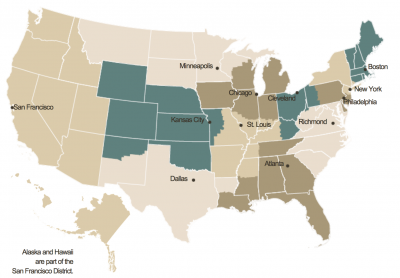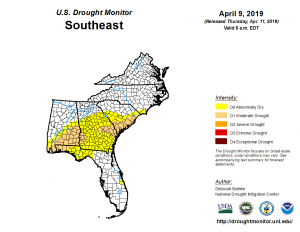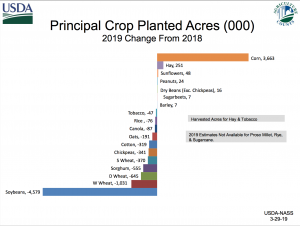Congress has quickly engaged in putting together potential aid packages for farmers that would more than double the Trump administration's $12 billion under the Farmer Bridge Assistance (FBA) Program.
Federal Reserve: Observations on the Ag Economy- April 2019
On Wednesday, the Federal Reserve Board released its April 2019 Beige Book update, a summary of commentary on current economic conditions by Federal Reserve District. The report included several observations pertaining to the U.S. agricultural economy.

* Sixth District- Atlanta– “Agricultural conditions across the District were mixed. Recent reports showed that much of the District was drought-free although some areas experienced abnormally dry to moderate drought conditions. In early March, tornadoes in Alabama damaged several thousand acres of timber. In late-March, weekly cash prices were up for corn and beef, while cotton, rice, soybean, broiler and egg prices were down from a year ago.”

* Seventh District- Chicago– “Farmers continued to be challenged by low corn and soybean prices. Flooding—primarily in the far western parts of the District—destroyed some farmers’ stored crops and was likely to delay fieldwork.
Contacts said they were hopeful for a resolution to trade disputes with China and a subsequent pickup in exports. Expectations of a future price rally led many farmers to continue to hold on to crops from last year’s harvest and to delay entering into contracts for this year’s harvest.
“Contacts expected particularly low soybean prices to push the corn-soybean mix closer to its typical 50-50 split following an increase in soybean acres last year. Livestock prices, especially for hogs, moved up in response to China’s decision to include livestock purchases in the trade negotiations and because of a considerable decline in China’s hog herd due to disease.”
* Eighth District- St. Louis– “District agriculture conditions have declined modestly since the previous reporting period and the same time last year. District cotton and corn acreages are expected to increase from last year by 12 percent and 4 percent, respectively, while rice and soybean acreages are expected to decrease by 1 percent and 6 percent, respectively.
This reflects reports by contacts that continued trade conflict with China has caused growers to shift production from soybeans to other crops.
Overall, acreage for the four main crops is expected to decline by 1 percent from last year.”

“Contacts have reported that the flooding of the Mississippi Valley is a major concern for growers and is expected to negatively impact timing and yields of crops this year.”
* Ninth District- Minneapolis– “District agricultural conditions remained weak. Heavy snows and resultant early spring flooding were likely to delay planting in many areas. In South Dakota and southern Minnesota, where flooding was most severe, the impact could be considerable.”
Days Suitable for Field Work, Week Ending April 14 - - Weekly Weather and #Crop Bulletin, @USDA- Office of the Chief Economist, https://t.co/mrjuIVy422 pic.twitter.com/QJzqSSiXnD
— Farm Policy (@FarmPolicy) April 16, 2019
* Tenth District- Kansas City– “The farm economy in the Tenth District weakened slightly from the prior reporting period, and severe weather conditions could weigh on the outlook moving forward. Across the region, corn and wheat inventories were slightly higher than a year ago, and prices for corn and wheat were slightly lower.
Soybean inventories in the District were significantly higher than a year ago, with prices moderately lower.
“In the livestock sector, a slight increase in cattle prices and a sharp increase in hog prices provided some support for revenues. However, recent severe flooding and blizzards throughout the District resulted in losses of cattle and stored crops as well as damage to roads, fields, and other infrastructure. Although the total impacts of the floods remained unknown as recovery ensues, conditions could put additional stress on some farm operations in the coming months.”
* Eleventh District- Dallas– “Soil moisture was mostly adequate, and there was a surplus in some areas, particularly the eastern part of the state.

“Some row crop plantings were delayed as a result of wet fields, but overall production prospects remained quite bullish. The wheat crop was in far better condition than last year thanks to favorable weather, but prices remained low leading some producers to consider harvesting the wheat for hay or silage, or grazing cattle on it. A large U.S. cotton crop was expected, which could depress prices, and there is still much uncertainty regarding tariffs.”
* Twelfth District- San Francisco– “Conditions in the agriculture sector deteriorated somewhat.
Many contacts continued to report that trade policy tensions and a stronger dollar constrained sales to export markets. A contact in Idaho noted that crop inventories rose to record levels as farmers waited for a resolution to trade negotiations and a recovery in various market prices.
“In addition, domestic demand for agricultural goods was mixed, increasing only slightly on balance. Oversupply in dairy markets persisted, hurting profitability and forcing some producers in the Mountain West to sell below break-even prices. Contacts reported that higher-than-expected rainfall since the beginning of the year positively affected agricultural production, but raised concerns that continued heavy rainfall could depress output ahead.”





